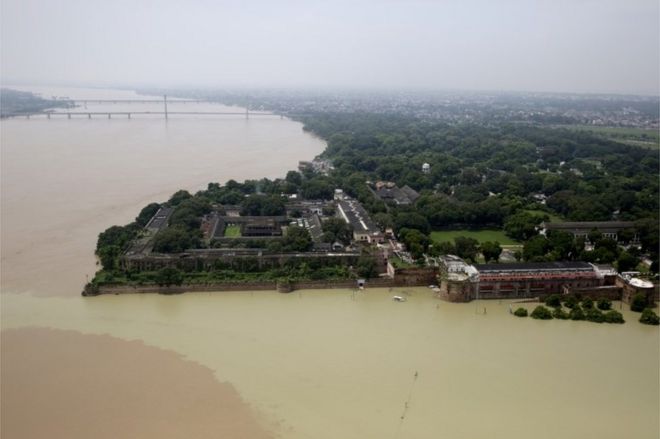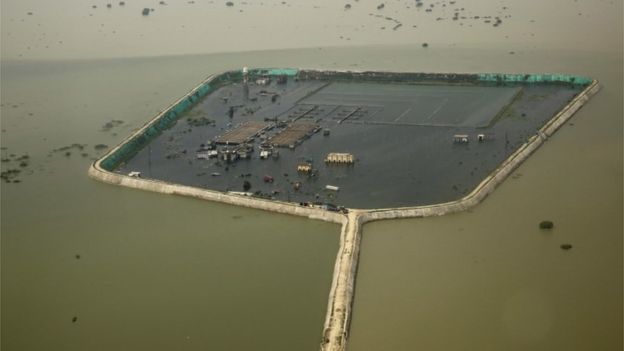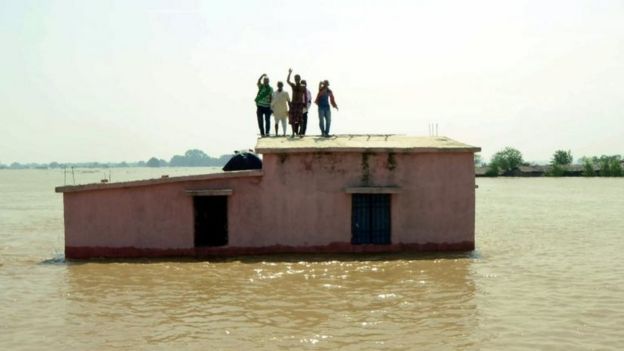- 30 August 2016
- India
-
(아시아/인도) 인도 갠지스江범람 이전 기록 갈아치우다국제문제/아시아 2016. 8. 31. 09:14
출처: http://www.bbc.com/news/world-asia-india-37217679
India Ganges floods 'break previous records'
 AP
APAn aerial view of the flooded Ganges river in Allahabad city The monsoon floods in India's Ganges river this year have broken previous records, officials have told the BBC.
They said water levels reached unprecedented levels at four locations in northern India.
The highest record was in Patna, the state capital of Bihar where flood waters reached 50.52m (166ft) on 26 August, up from 50.27m in 1994.
Floods across India this year have killed more than 150 people and displaced thousands.
'Unprecedented' 일찌기 없던 일, 전례가 없던 일
"We have also recorded unprecedented flood levels at Hathidah and Bhagalpur of Bihar state and Balliya of Uttar Pradesh," chief of India's Central Water Commission GS Jha said.
"In all these four places, the floods crossed the previous highest flood level and they all were unprecedented."
Bihar is one of the worst flood-hit states in India with at least 150 deaths and nearly half a million people evacuated.
Neighbouring Uttar Pradesh has also been severely affected by floods in the Ganges.
 AP
APThe holy city of Varanasi has been submerged by the swollen Ganges  AP
APThe Ganges has inundated large swathes of Uttar Pradesh state (inundated: 침수시키다) (swathes: 기다란 모양의 땅) The third largest river in the world flows through these north Indian states meeting its tributaries before emptying into the Bay of Bengal.
The Indian Meteorological Department, however, has recorded deficient rainfall in these states past week and average rains since the monsoon started in June. (deficient: 부족한)
Breaking embankments 제방을 무너뜨리다 (embankment: 둑, 제방)
Some experts have blamed the silt the river carries for the floods. The Ganges is one of the highest sediment load carrying rivers. (silt: 유사, 토사) (sediment load: 유사流砂)
The silt deposition is said to have raised the river's bed-level causing it to break embankments and flood the adjoining human settlements and farmlands. 유사퇴적물이 위험한 이유: (1) 제방붕괴. (2) 인간의 거주지와 농지를 파괴. (silt deposition: 유사퇴적물) (adjoining: 인접한, 인근의)
Is India facing its worst-ever water crisis?
Officials in Bihar have demanded that an artificial barrier in neighbouring West Bengal state bordering Bangladesh be dismantled to solve the silt problem. 인도 갠지스江 범람의 한 원인: 한국의 4대강에 설치한 보와 같은 인공장벽. (artificial barrier: 인공장벽)
They argue that the deposition of silt has obstructed several passages through the Farakka barrage. (obstruct: 막다, 방해하다) (barrage: 하류막이 공사 혹은 보)
As a result, they say, the Ganges' water flows back to Bihar and causes floods.
Silt deposition has also significantly raised the water level of Kosi river, one of the major tributaries of the Ganges. 유사퇴적물이 위험한 이유: (3) 강물의 수위를 높임.
 AP
APThe Ganges is flowing above the danger mark in Uttar Pradesh "The silt has so much accumulated in the river that we fear it might cause the water to damage the Kosi barrage and embankments," said Dev Narayan Yadav, a river expert pointing at the barrage built in the early 1960s.
"The silt has raised the river level higher to our villages' grounds, so you can imagine what risks we face."
Chronic problem 만성적인 문제인 강의 범람도 통제 가능
The BBC saw silt piling up and threatening to block many of the gates of the barrage on Kosi river, which is built and operated by India in Nepalese territory.
Some geologists say increased incidents of landslides in the Himalayan region have resulted in increased silt in the rivers flowing down to meet the Ganges. 토사의 근본적 원인: 히말라야 지역의 산사태. 이 흙이 강물을 타고 갠지스江지역으로 흘러내림.
"Since these are alluvial rivers carrying sediment loads, if we can control the silt then we will be able to manage the floods that have become chronic problems in the Ganges basin," said Mr Jha.
 AFP
AFPBihar is one of the worst-affected states  AP
APFloods across India have displaced thousands The Wadia Institute of Himalayan Geology in Uttarakhand state has also identified silting as the major flooding problem. 유사의 퇴적이 범람의 원인.
"Therefore de-silting of the rivers is the need of the hour and it needs to be done scientifically, from the middle of the rivers," said Professor Anil Kumar Gupta who heads the institute helping the government in geological issues.
Sand mining
Following uncontrolled sand mining from rivers across India for commercial purposes, India's Supreme Court in 2014 ordered a ban on extraction without a licence.
"Such sand mining was mainly done at riversides disturbing the flow of the rivers, therefore the silt will now have to be removed from the middle of the rivers."
India's central water resource authorities, however, believe construction of dams will deal with the problem effectively.
"Non-structural measures like moving people to safe areas have not been effective enough," says Mr Jha.
 AP
APThe silt deposition is said to have raised the river's bed-level causing it to break embankments  AP
APThe Ganges is the third largest river in the world "The dams we plan to build will store flood waters to prevent flooding and they will also have the technology to take care of the silt."
He said the Central Water Commission aimed to build three major dams - two in upstream Nepal and one in Arunachal Pradesh.
"They have been planned for quite sometime and we are certain that we will be able to build them and solve the chronic problem of floods."
'국제문제 > 아시아' 카테고리의 다른 글
(아시아) BBC: 북한의 '최대' 핵실험 국제사회 제재 초래 (0) 2016.09.10 (아시아) '창녀의 자식'이란 욕을 먹은 오바마 필리핀 두테르테와 회담 취소 (0) 2016.09.06 (아시아) 남북한 체조선수 올림픽 기념셀카 찍다 (0) 2016.08.10 (아시아) 일본왕 아키히토 퇴위 시사 (0) 2016.08.09 (아시아/인도) 왜 인도의 이발소는 특별한 제도인가? (0) 2016.08.07